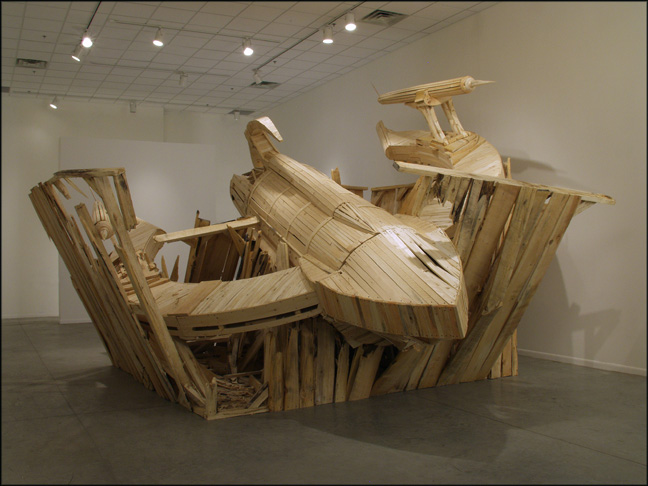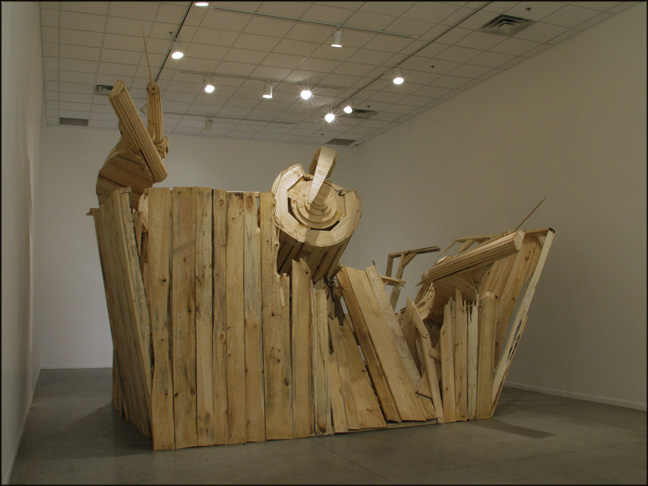Art Review: Arms and the Boy: Chris Larson at Franklin Art Works
Chris Larson's show at Franklin Art Works is a larky and affectionate look at the past of the Future--given added poignance in the current moment, awash as we are in Imperial America's dreary imagery of power.


“Chris Larson: Sculpture, Film, Prints”
April 10 – June 5
Franklin Art Works
1021 East Franklin
Minneapolis, MN 55404
In the main room at Franklin Art Works, in a cloud of resinous scent, a crashed rocketship is nested in an explosion of fractured boards, the remains of a shack, some kind of dwelling. Buck Rogers has apparently just crawled out of the wreckage and gone to reconnoitre. The design of the ship—geekily cool, a Streamline Moderne rocketshippe with swooping fins that end in knobs—is weirdly served by its rough-and-ready construction in unplaned lumber and sheetrock screws.
Fascination with the machine, the machine’s betrayal of its operator’s body, the consequent danger made comic and sexy—these are mostly familiar landmarks in Larson territory, but this work is more playful and satisfying than the vaguely medieval wooden work/torture machines he used to make.
This freebooter’s vessel gives rise to suppressed fantasies of what power could be–individual daring! exploration! invention!–before the American Imperium and its Patriot Acts shut down any such possibilities for the duration. But that’s what the parallel reality known as “art” is for, often–to serve as a sort of bank of possibilities disallowed by current realities.
Larson noted in his artist talk that, instead of sketching plans for his sculptures, he writes little stories that describe them, stories that he keeps private. He once showed the stories with the work, he said, but no longer wants to. The stories tend to preempt the viewer’s attention and prevent real perception of the sculpture. He apparently, then, builds these things raw, without a drawn plan or sketch: saws, fastens, rejiggers, the whole thing, in a sort of improvising process.
This is pretty impressive with a work this large and complex—and it’s a working process that reveals an intense fascination with physical making and the difficult interaction of maker’s body and the body of the made, evidenced in some form in all of Larson’s work. In this world the machine is an embodied intention that enslaves its users even while it serves them: it’s also a really nifty image out of a comic book, a projection of an adolescent desire to be mastered by one’s tools of mastery.
This show also includes a video that harks back to Larson’s earlier work, sexualizing the human/machine symbiosis with lots of drippy viscous fluids and the fact that the crude and encompassing machine is manipulated (by New York-based video artist Rico Gatson—you may have seen his work at Franconia) by mouth. This 10-minute exercise in the theater of laboring orifices is less interesting than the sculpture. It gives rise to fewer lines of association, and is portentous without being meaningful, despite its play with black and white skin and black and white fluids mingling. There’s maybe potential meaning there, but it’s not claimed by the work—it just sort of hangs in the air around it.
The drawings/prints are a surprise. Larson has said that he “doesn’t draw,” and these drawings refer to Leonardo’s fantastical inventions—hardly a source for a non-draftsman. (Larson has said that they come from da Vinci’s sketchbooks, which the printmaker he works with showed him.) On closer inspection, it’s true that he didn’t “draw” these Rube Goldberg assemblages, these impossible machines. They’re made up of bits and pieces that he’s traced onto vellum, lifted from Da Vinci’s drawings. They use, in other words, a mechanistic technique to create marks that have no feeling of the hand, no sense of gesture or invention. In their own way, they’re the product of a “drawing machine”—another offgassing of Larson’s obsession with human/machine pairing. They will become lithographs. What’s on the wall now are digital prints (giclees) of graphite drawings.
This show ranges widely across media, and is very ambitious in its attempt to cover the same theme from many different points. The results are uneven—the sculpture becomes its own entity in a way that none of the other works do–but they show a new level of maturity, paradoxically, in the artist’s playfulness with themes he earlier earnestly belabored.
Photos by Rik Sferra, courtesy Franklin Art Works